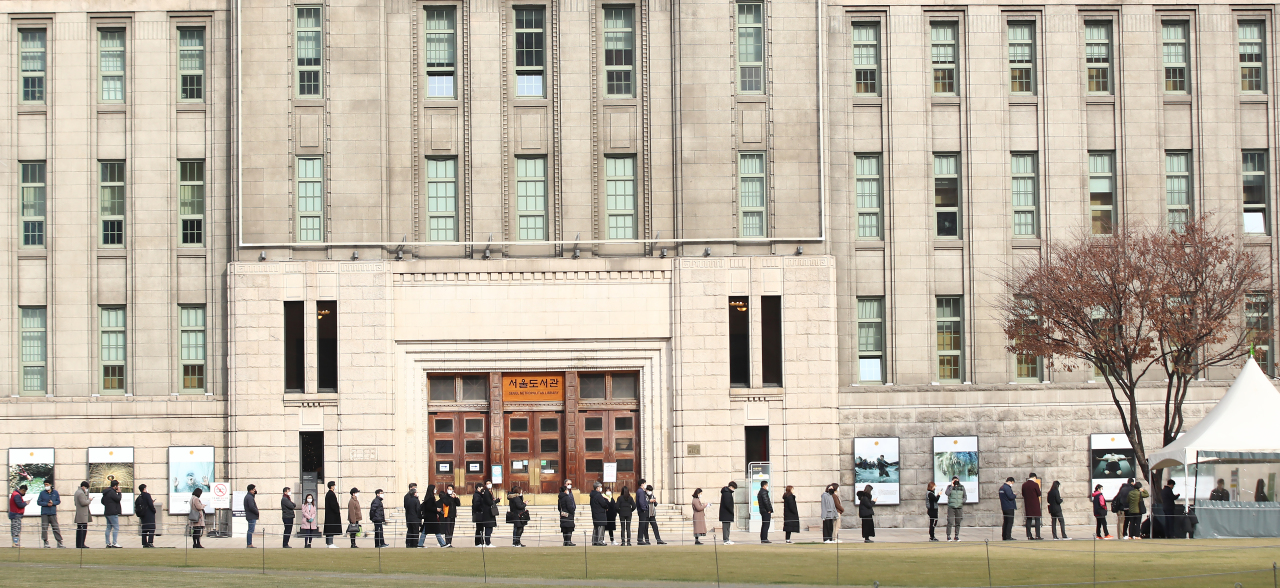New infections in 7,000s for 2nd day
Number of COVID-19 patients in serious condition hits all time-high
By Im Eun-byelPublished : Dec. 9, 2021 - 14:54

South Korea on Thursday fell deeper into the COVID-19 crisis, reporting over 7,000 new cases for a second consecutive day while critical cases hit an all-time high.
The Korea Disease Control and Prevention Agency said 7,102 cases were reported in the 24 hours ending Wednesday at midnight, putting the country’s total number of cases to date at 496,584.
It is the second-highest tally of daily cases since the pandemic began nearly two years ago. On Tuesday the country reported 7,174 cases.
The number of patients in serious condition, 857, also reached its highest point yet. Some 83.4 percent of them are 60 or older.
“The fatality rate in confirmed cases is on the increase as more elderly are getting infected,” Son Young-rae, spokesperson for the Health Ministry, said at an online briefing Thursday.
The total average fatality rate, which refers to the number of deaths in confirmed patients up to now, was 0.82 percent as of Thursday. The fatality rate in the past week was 1.42 percent, 0.01 percent higher than the world average of 1.41 percent.
“Elderly patients account for more than 30 percent of the total confirmed cases. Two or three months prior, they took up some 20 percent,” Son said. “As the rate of elderly confirmed cases has increased, the fatality rate has been going up.”
Though the number of virus cases is snowballing, the authorities have not rolled out new social distancing rules yet.
“As strengthened social distancing measures took effect from Monday, their results will show from the end of this week. We are monitoring the situation,” Son said. “We are discussing extra measures and the right time to put them into effect.”
With more than 76 percent of confirmed cases concentrated in Greater Seoul, the region’s medical capacity is strained. In the area, which encompasses Seoul, Gyeonggi Province and Incheon, 5,418 people newly tested positive for the coronavirus.
According to the authorities, 85 percent of hospital intensive care beds in Greater Seoul for COVID-19 patients are now occupied.
To alleviate the shortage of hospital beds in the area, authorities are sending COVID-19 patients to other regions. However, the occupancy rate for hospital beds in other regions for COVID-19 patients in serious condition is also high, at 67.7 percent.
There were 22 new cases of infection with the omicron variant, pushing the total to 60. Of those cases, six were imported cases from South Africa, Mozambique and Ethiopia, and 16 were domestic transmissions. It is the first time Korea has confirmed more than 20 omicron variant cases in a day.
As of Wednesday at midnight, 80.8 percent of the Korean population was fully vaccinated. For people 18 and above, the figure was 91.9 percent. Some 9.4 percent of the Korean population, 4.84 million people, had received booster shots.
Meanwhile, the authorities are expecting the number of daily confirmed cases to reach 8,000 by the end of this month.
According to Central Disease Control Headquarters data submitted to Rep. Suh Jung-sook of the People Power Party on Thursday, authorities expect to see daily case counts between 8,000 and 9,000 by the end of this month if the wave worsens due to colder weather and relaxed measures. The tally could go up to between 8,000 and 11,000 around the end of January, authorities said.
If the virus wave continues without worsening, authorities expect the daily case numbers to stay between 6,700 and 8,000 by the end of this month, and between 5,900 and 8,400 by the end of January.
By Im Eun-byel (silverstar@heraldcorp.com)







![[Graphic News] More Koreans say they plan long-distance trips this year](http://res.heraldm.com/phpwas/restmb_idxmake.php?idx=644&simg=/content/image/2024/04/17/20240417050828_0.gif&u=)
![[KH Explains] Hyundai's full hybrid edge to pay off amid slow transition to pure EVs](http://res.heraldm.com/phpwas/restmb_idxmake.php?idx=644&simg=/content/image/2024/04/18/20240418050645_0.jpg&u=20240419100350)








![[KH Explains] Hyundai's full hybrid edge to pay off amid slow transition to pure EVs](http://res.heraldm.com/phpwas/restmb_idxmake.php?idx=652&simg=/content/image/2024/04/18/20240418050645_0.jpg&u=20240419100350)

![[Today’s K-pop] Illit drops debut single remix](http://res.heraldm.com/phpwas/restmb_idxmake.php?idx=642&simg=/content/image/2024/04/19/20240419050612_0.jpg&u=)